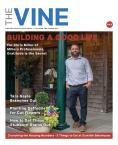In an ideal world, we’d tap our ruby slippers together and our homes would be optimized for energy-efficiency, our gardens would be filled with native, drought-resistant plants, and our carbon footprints would have shrunk to half their size. Change doesn’t happen that way, of course. And full-scale overhauls can be daunting. But making small changes, one or two upgrades at a time, can get us moving in the right direction. Even making a phone call – say to Cape Light Compact for a free home energy assessment – can open a window of opportunity.
Next, we have only to turn to our neighbors. On the Vineyard, we have a wealth of knowledgeable professionals and experienced volunteers who can answer our burning questions. Armed with some answers (read on!), we can head into the Island’s first annual Climate Action Week (May 8-14) with a sense of purpose – or at least some minor plans.
Building Smarter
Q. When designing a new house, what are the two or three most important areas to focus on for energy efficiency?
A. Any project looking to be efficient should first consider size. Think smaller and compact. The more sufficient and efficient the spaces are, the more is saved in materials and embodied energy, and in future energy demands. Once you have shrunk the building, then build a well-insulated house that uses the sun to help heat the home through passive solar gain. A well-insulated house would also consider window placement as well as the insulating value of the windows one chooses. — Ben Robinson, chair of the Martha’s Vineyard Commission Climate Action Task Force and MVC commissioner
Q. How important for energy efficiency are the type of windows I choose?
A. What the window frame is made of will impact its performance in the home. It is critical in New England to use a window that has a thermally broken frame — that is, a frame that does not transmit or conduct the outside temperature to the inside of the house. Glass will also have a huge impact on the performance of a window. A baseline expectation would include the use of double-glazed/insulating glass. We also use triple-glazed/insulating glass for clients who want a heightened level of comfort in the home.
Also, the operation or style of window can make a big impact on energy efficiency. We build homes much tighter these days than we did in the past. A window that minimizes air infiltration is best in this regard. While we all love a classic double-hung window, they tend to have higher air infiltration rates since they have more moving parts than other window types. Awnings, casements, and tilt-turn windows are all single-sash windows that only hinge on one side (like a door) and therefore close more tightly as compared to a double-hung window.
Location of windows is also key. We always look for opportunities for passive solar design where the home will benefit from the right amount of solar gain (or passive shading) over the course of the year. These considerations become the basis of design for the rest of the project, and the location of windows goes hand in hand with the location of rooms. We also look at seasonal changes in the sun’s position, since how we utilize our home changes from season to season based on the sun’s orientation. — Greg Ehrman AIA, partner, Hutker Architects
Q. When having my house painted, what are the best practices, environmentally speaking?
A. Goodbye to the old standard of oil-based paint. Today the overwhelming favorite for many exterior housepainters — as well as homeowners — is acrylic latex paint, which is generally considered to be better for the environment. It works better on today’s composite building materials, and the time it takes to dry is much less than oil-based paint. We also can work longer in cooler temps. Using oil-based paint also usually requires cleaning up with effective but potentially toxic materials that can end up in our waterways, soil and septic systems.
It’s a good idea to be aware that many paints and primers (including acrylic latex) contain volatile organic compounds (VOCs) that can evaporate readily at room temperature [potentially causing you to feel ill]. Examples include some pigments and midewcides. Choose a paint with zero to low VOCs and do not use exterior paint on interiors. — Rick Convery, owner, Rick Convery Painting
Q. If I’m buying or building a new home on the Island, what should I be thinking about in terms of flood protection?
A. Think hard before buying a home in or near a flood zone; flooding is only going to increase as the sea rises. New homes and substantially renovated homes in a flood zone have to be raised above the flood elevation. This protects the house; but remember it does not protect your access to and from the house when the roads flood, including in an emergency. Ideally, homes would be removed from the flood zone to protect public health and safety and to allow the land to absorb and contain the floodwater.
You can find out if your house is in a flood zone by checking FEMA maps online (msc.fema.gov/portal/home) or at your Island town hall. If you’re purchasing a home, your mortgage company will also research and require flood insurance if you are in a flood zone. — Liz Durkee, Climate Change Planner, Martha’s Vineyard Commission
Q. If I’m building a new home, how important is the siting of my house for energy efficiency?
A. Siting is of utmost importance in planning, for many reasons: views, topography, access, landscape features, existing vegetation, and also energy efficiency. Gentle south facing slopes offer the ideal siting; buildings should use the sun to help offset heating needs through passive solar and to help in creating a block to colder northern winter winds. Landscaping can further add to this shield from the north. — Ben Robinson, chair of the Martha’s Vineyard Commission Climate Action Task Force and MVC commissioner
Going Green — and Modular
With the increased popularity of modular homes on the Vineyard, we were curious about how they compare to traditional onsite building in terms of energy efficiency and environmental impact. We asked Squash Meadow Construction president Bill Potter to give us some perspective, and we learned that energy efficiency was a key driver in Bill’s decision to move towards modular building in the first place.
Q. What aspects of modular homes offer a more environmentally friendly building experience over typical construction?
A. We feel that modular homes are the way of the future. We [Squash Meadow] started working with modular homes in 2007 specifically because of energy efficiency. Clients were coming in with questions about green building. We chose to work with Westchester Modular Homes and built our first prototype on East Chop, which won an Energystar award and got LEED (Leadership in Energy and Environmental Design) Gold certified.
Modular construction involves less waste across all points of the process. It takes 67% less energy to build a modular home than to build a home on site. The house can be cut and made in the factory in seven days, compared to the six to nine months it takes to do new, on-site construction. That’s a lot less gas being consumed by workers driving to and from the job site every day. At the factory, everything is cut to order and stacked neatly. The materials stay dry. Not as much lumber is being dropped off and thrown away. And whatever waste there is ends up going to recycling. Also, modular homes are made tighter so there’s less air infiltration. The sheetrock is glued and screwed instead of being sheetrocked to a stud.
Q. When a home’s components are made in the factory, are they made from materials that are“green” or more environmentally friendly?
A. The majority of the components in each house are made from pre-consumer or post-consumer recycled content. As often as possible, we use materials with no volatile organic compounds (VOCs), which are chemicals found in solvent-based and water-based paints and coatings. People who have had their houses painted recently might be aware of “no VOC” paints like ones available from Benjamin Moore. We also work with materials that don’t have formaldehyde and those that do have a “Green Label” stamp. The lumber is sourced from forests that are properly managed.
Q. If I’m building a modular home, what type of energy-efficient heating system will I likely be looking at?
A. All homes are subject to evaluation on the HERS (Home Energy Rating System) index. Recently, this has become part of the building code, but we have been following it for 15 years; it has been part of the LEED for Homes building criteria. A HERS rating takes many factors into consideration when coming up with a score: the efficiency of the heating and cooling systems; the tightness of the house; the efficiency of the appliances and whether the house has renewable energy such as solar. Each house is “engineered” with the correct heating system. This could be a super-efficient propane gas furnace or a heat pump/mini-split. For hot water, we generally use an on-demand system that is only using energy to heat the water as needed.
Searching for Energy Efficiency
Q. Should we be converting most of our home systems to electric energy? If we have to start in a few key places, what would they be?
A. Definitely. For example, if a typical Vineyard house that uses propane converts heat, hot water, clothes drying, and cooking (and pool heating if that is part of the mix) to electric heat pumps, heat pump dryers, and induction cooktops (which are 2 ½ times more efficient than gas), the carbon emissions will go down 35 to 40%. And that’s without any reduction of the load from building enclosure upgrades, and without adding solar electric. — Marc Rosenbaum, founder, Energysmiths
Q. Are heat pumps the most efficient option for people seeking to achieve energy efficiency?
A. We talk about two types of efficiency — operating efficiency and financial efficiency. Operating efficiency is about how a system performs. Regarding performance, heat pumps are much better than any system using fossil fuels. Generally, it’s four times more efficient to move heat rather than to generate it, and it’s more sustainable to make electricity. Even with an electric baseboard, you put a kilowatt of energy in and a kilowatt comes out, but with the heat pumps, we can get two, three or four watts of energy out because we’re getting the energy from outside.
At our office [Nelson Mechanical Design on State Road], we’ve combined solar panels with heat pumps. Our building is net zero over this year: We produce more electricity than we are using. That’s sustainability.
Heat pumps are also cost effective because, in the long run, the systems operate at a cost savings compared to propane and oil. There’s a calculator on the Mass Save website (masssave.com) where you can punch in your zip code and it generates an educated guess on the estimated costs for oil and propane versus a heat pump.
You have to look at the costs in terms of the life of a system. Almost anything will pay for itself over five years. At this point, heat pumps are still considered “disposable” systems, but they have a life expectancy of 12 to 15 years. Mass Save is supporting homeowners by helping to make the initial cost of installing a heat pump less expensive. They’re giving a ton of money in rebates to homeowners who switch over to heat pumps. They’re also making loans, or helping homeowners find loans. You can find ways to make the switch budget-neutral.
Overall, my recommendations for people seeking energy efficiency are: Weatherize, get better windows, install cold climate heat pumps, and install solar. If you can afford to install both a heat pump system and solar panels, you should do it. — David Sprague, co-owner, Nelson Mechanical Design
Q. Does it make sense to add solar panels to a home if you haven’t upgraded other energy systems?
A. For most people, a solar electric system is a good financial decision that can stand on its own without other decarbonization/energy saving measures. In the best case, an overall assessment is done to see what other upgrades may make sense either at the same time or as part of a clear master plan. For example, if the roof is old enough to be replaced, and the house is leaky and under-insulated, adding an air barrier and insulation as part of the roof replacement would make sense. – Marc Rosenbaum, founder, Energysmiths The Dish on Washing and Drying As a practicing architect, a member of the Martha’s Vineyard Commission, and chair of the Martha’s Vineyard Commission’s Climate Action Task Force, Ben Robinson is constantly thinking about sustainable solutions to the ways we live and build our homes on the Island. But Ben and his family also embrace sustainable practices at home, which is why we posed to him a few basic questions about home appliances.
Q. What’s better – a front-loading or top-loading washing machine? And what is the most energy-efficient clothes dryer?
A. There is not much difference with modern washing machines, front- or top-loading. You should consider how often you wash and what you wash. Don’t use plastic or synthetic clothing, since this is a primary way that micro-plastics and associated chemicals find their way into our groundwater. Also consider the soap you use in regards to chemicals and antibacterial additives.
In terms of dryers, the sun is the best, most energy-efficient dryer you can use. And direct sunlight also acts as a disinfectant. So just hang your clothes outside, even in the winter, and if it’s too wet out or below freezing without enough wind to evaporate and dry, hang your clothes inside. As an added benefit, you humidify the air with drying clothes. Also air-dried clothes last longer, as the dryer wears down the fabrics more quickly. So just try to avoid using the dryer as much as possible. If you have a dryer, go electric and eliminate the need for propane.
Q. Should we be handwashing our dishes or using our dishwashers more?
A. Depending on how well you hand wash — Do you let the water just run? Are you efficient with the use of soap? Do you have a system that limits the water you use? — you could be more efficient than a dishwasher. But if you don’t have a good system, you are likely using more water and more soap than a good dishwasher would, and you will be less efficient.
Planning an Eco-Friendly Landscape
If you are about to embark on a good-sized landscaping project – whether for a new home or an old one — you’ll want to get up to speed about best practices for making that landscape environmentally friendly, from welcoming wildlife to controlling erosion to avoiding light pollution. We talked with Dan K. Gordon, Principal of Dan Gordon Landscape Architects, who said that sustainability is increasingly a concern with the firm’s projects. To wit, he offered us his top ten list of considerations when starting a project.
Q. When planning a landscaping project – whether for a new home or as part of a renovation – how can I make my project as environmentally friendly as possible?
A. There are many things you can do. Here are our top ten considerations:
1. Make sure to protect your existing resource areas and wildlife habitat areas and incorporate them as a central part of your design.
2. Maximize light and reduce energy costs by considering site conditions such as solar orientation, prevailing winds, topography and vegetation.
3. Use current technology, including smart systems for irrigation, to improve efficiency and reduce waste.
4. Develop a landscape design which incorporates and fosters native plants. Native plants can reduce the need for irrigation, pesticides and maintenance.
5. Manage stormwater to eliminate erosion and slow runoff; use rainwater for irrigation and wildlife.
6. Reuse and recycle existing site structures and resources; source plant and stone materials locally.
7. Reduce impervious surfaces and when necessary, use paving with reduced heat absorption; consider green roofs when possible.
8. Use LED and Dark Sky-compliant lighting systems to reduce energy needs and light pollution.
9. Incorporate eco-friendly maintenance practices, from electric maintenance equipment to integrated pest management to natural and organic fertilizers.
10. Build a landscape that will stand the test of time, that will endure and enhance the environment.
About That Lawn and Those Leaves
Q. Is it possible to have an eco-friendly lawn?
A. Yes, this is possible if you manage your expectations. Your lawn won’t be as lush without traditional pesticides and fertilizers, and environmentally friendly products may take longer or be more costly to implement. But we can start reducing our dependence on traditional chemical applications by choosing the right grass blends that can do better on their own. Next we should be using a deep layer of high-quality soil so that grass roots can grow deep and draw nutrients from the ground, and withstand bouts of drought and disease better. Lastly, the mowing — in an ideal situation you wouldn’t pick up the grass clippings but would mulch them and leave them on the lawn to act as natural fertilizer as they decay.
An eco-friendly lawn is actually better for the environment than mulch, wood chips, or any type of hardscape element. Grass is a living plant so it will help with air pollution, stormwater runoff, carbon dioxide, and other pollutants and produce clean oxygen like any other plant. A 50’ x 50’ foot lawn will produce enough oxygen for a family of four people. It’s a popular misconception that lawns are bad for the environment. It’s not the lawns that harm the environment, only some of the methods in which they are maintained. — Jesse Fuller, owner, The Fullers Company
Q. What are ways to keep my eco-friendly lawn healthy?
A. The most important issue with lawns is the soil. It’s always best to do a soil test to see what organic nutrients may be lacking. The results will inform you of what is needed to get your soil healthy. The test will also recommend the ratio blend of nitrogen, phosphorus, and potassium needed. Adding the proper ratio of organic material to your lawn will promote healthy growth. Organic fertilizers feed the root system, creating a thick healthy lawn. Keeping the height of the grass at three inches or above is the best way to keep weeds from germinating and pests invading. — Jude Villa, owner operator at Working Earth Organic Gardening and Landscaping
Q. What are some environmentally friendly alternatives to lawns?
A. Growing food on your own property is one of the key things you can do to help mitigate climate change. The more food we purchase from other places, the more carbon we’re using. If you grow your own, you don’t have to leave your backyard (or maybe your front yard)! If you’re a renter, see if your landlord would allow a container garden. Nurseries and garden centers often have extra plant containers around in the spring; some will give them away for free.
If not a food garden, we can turn our lawns into eco-lawns by planting grass seed that doesn’t require fertilizer and mowing. We just need to change our mindset about what a nice lawn looks like. You can also take part of your lawn and convert it into an area for native plants and pollinator plants that will attract beneficial insects. Use a variety of different flower shapes, colors, and sizes; some favorites are coneflowers, butterfly weed, Mexican sunflowers and anise hyssop. Or you can convert some of your lawn to shrub borders that will help bring various wildlife into your yard. Cranberrybush viburnum, shadbush (or serviceberry), clethra (pepperbush), and highbush blueberry are top choices for attracting birds and bees. — Roxanne Kapitan, landscape designer with Oakleaf Landscaping and regenerative gardening educator
Q. How can we attract more wildlife and diversity to our properties?
A. Most of the actions are simple and just require thoughtfulness. They include rethinking and limiting your lawn space so there is more living space for plants, possibly converting some to meadow; removing invasive species because they have higher CO2 conditions that negatively affect our ecosystems; providing animals with a water source like a birdbath or fountain on your property; and creating brush piles of branches, twigs and leaves so that animals have places to nest and to take cover from predators.
I encourage people to plant more trees and in particular to plant more native species. Oaks as a species are a keystone to how our ecosystem functions. They provide homes to butterflies, moths, and birds; their leaves and bark are used by animals as food and provide essential nutrients; and oaks fight climate change by sequestering carbon for significant amounts of time. — Angela Luckey, program director National Neighbors Program, Biodiversity Works
Q. Gas-powered leaf blowers are a big source of sound pollution and they are fuel guzzlers, too. Is there an alternative?
A. You have three options. Of course, you can allow leaves to remain on your lawn and surfaces; you’d have to be comfortable with that look. You can manually rake. Or you can use an electric blower instead of a gas-powered one. We much prefer using electric blowers as they are quieter, easier to use, less costly to operate, and require less maintenance. But they currently have some limits. Because they operate at somewhat lower speeds and can only push an air volume of up to about 60 percent of what a gas-powered blower can, a clean-up job can take longer. For a small yard on a fairly dry day, it might not matter, but for a larger yard or if the leaves are damp, it makes a big difference. Many homeowners may be okay with a longer clean-up time (and higher cost if hiring landscapers), but others will not.
As battery technology improves and costs go down, there will be electric blowers that can compete better with gas ones. Right now the size of the battery and electric motor you’d need to equal a gas blower would be too heavy for a person to comfortably operate. But soon the batteries will be smaller. — Jesse Fuller, owner, The Fullers Company
Cutting Back on Food Waste
Noli Taylor, food equity advocate and senior director of programs of Island Grown Initiative, quickly got us up to speed on the state of food waste in this country: Forty percent of the food produced in America is never eaten and the average American household of four loses $120 each month to wasted food. Once discarded, Noli explained, that wasted food has a serious climate impact and greenhouse gas footprint. The production, packaging, and shipping of food is a major driver of greenhouse gas emissions, and when food is wasted, the methane released by decomposing food in landfills increases the climate impact. Six to eight percent of all greenhouse gas emissions are attributable to wasted food. In the United States, the Environmental Protection Agency (EPA) estimates that the emissions from our wasted food are equivalent to 42 coal-fired power plants, not even counting the methane emissions from landfills.
Knowing that food waste is one area where we can make an impact with small changes, we asked Noli for some tips.
Q. What are some of the best ways to handle our food waste?
First and foremost, I recommend arming yourself with the Waste-Free Kitchen Handbook by Dana Gunders. Then try to incorporate some new habits into your food planning and preparation routines:
• Plan ahead prior to shopping trips.
• Freeze what you won’t use in a few days.
• Use less-than-perfect fruits or vegetables in smoothies, soup stocks, or sauces instead of throwing them out.
• Buy frozen foods when local fresh food isn’t available — frozen foods waste less all along the supply chain.
• Put a box in your refrigerator that says “Use Me First!” to remember where to start when making a meal.
• Sometimes “use by” or “best by” dates can be misleading and can be tools for food companies to sell even more when the food is perfectly good past those dates. Use your sense of sight and smell to double-check those “best by” dates.
• When you do have food scraps to dispose of, instead of sending them to the landfill or the incinerator by putting them in your trash, compost them at home or bring them to your local transfer station or to Island Grown Initiative (IGI) to be turned into compost. IGI will use that compost to grow more food for the Island.
All illustrations by Chris Burrell.













Comments